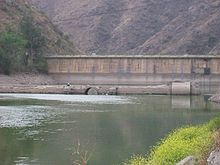Lago San Roque
| Lago San Roque | ||
|---|---|---|

|
||
| Geographical location | Cordoba Province , Argentina | |
| Tributaries | Río San Antonio , Río Cosquín | |
| Drain | Río Suquía | |
| Places on the shore | Villa Carlos Paz | |
| Location close to the shore | Cordoba | |
| Data | ||
| Coordinates | 31 ° 22 '23 " S , 64 ° 27' 53" W | |
|
|
||
The Lago San Roque , also Dique San Roque and Embalse San Roque , is a reservoir in central Argentina in the province of Cordoba . It is located in the south of the Valle de Punilla , at the western end of the Gran Córdoba agglomeration , 25 km from the city of Córdoba .
History and economic use
The first dam was built in 1914 for the purpose of generating electricity and as a drinking water reservoir for Cordoba. The hydropower plant was the largest in the world at the time. In 1944, a second dam wall was built behind the original one, raising the water level significantly (see San Roque dam ). Today the power plant only plays a subordinate role in the supply of electricity; some of it has since been shut down and converted into a museum. The importance of the reservoir for regulating the drinking water supply for the city of Córdoba is still enormous, as the region has pronounced rainy (summer) and dry seasons (winter). Because of the strong population growth, water from the reservoir is now also processed as drinking water in Carlos Paz .
geography
The lake bundles the two relatively water-rich rivers Río San Antonio and Río Cosquín , both of which have their source in the Sierra Grande . Behind the San Roque dam , the outflow is called the Río Suquía or Río Primero.
Population and tourism
There are numerous tourist centers around Lake San Roque. The most important is Villa Carlos Paz (approx. 60,000 inhabitants) on the south bank, next to it is Bialet Massé (5,000 inhabitants) on the north bank. Due to the small extent, apart from park-like private areas, there are only a few undeveloped areas on the lake, the most important (approx. 6 km long) is to be found near the dam on the east bank, as the bank there is steep and rocky because of the Sierra Chica mountain range and difficult to build on. A serious nature conservation policy does not take place in this regard, on the contrary, all neighboring towns are continuously expanding their built-up area to this day. In the smaller towns in particular, the population rises sharply: 4% per year in Carlos Paz, by 8% (Bialet Massé, Santa Cruz, Parque Siquiman) to 12% (San Roque) and even 75% in the case of the smallest town, Villa Lago Azul, which has only existed since the early 1990s.
Swimming in the lake is only permitted in some favored areas away from Carlos Paz due to the high pollution of the water. Nevertheless, it is used, especially in summer, to practice many water sports (including windsurfing , water skiing ) and by providers of boat trips.
Neighborhoods
The following cities and towns border Lake San Roque (clockwise from south to north, population in brackets):
- Villa Carlos Paz (56,407)
- Santa Cruz del Lago (1,637)
- Villa Lago Azul (169)
- Villa Parque Siquiman (816)
- Bialet Massé (4,543)
- Comuna San Roque (832)
Population source: 2001 census
credentials
- ↑ Comparison of the 1991 and 2001 censuses, source: INDEC ( Memento of the original from December 28, 2009 in the Internet Archive ) Info: The archive link was inserted automatically and has not yet been checked. Please check the original and archive link according to the instructions and then remove this notice.
- ↑ See INDEC ( Memento of the original from December 28, 2009 in the Internet Archive ) Info: The archive link was automatically inserted and not yet checked. Please check the original and archive link according to the instructions and then remove this notice.

